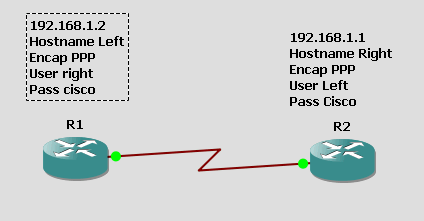Configuration and troubleshooting serial links on Cisco routers.
Basic configuration. Default protocol is HDLC. After both sides are configured, ping is possible immediately. Most connections use PPP.
R1(config)#hostname left
left(config)#username left password cisco
left(config)#int s1/0
left(config-if)#ip address 192.168.1.2 255.255.255.0
left(config-if)#no shut
left(config-if)#exit
left(config)#
Configure PPP
left(config)#int s1/0
left(config-if)#encap ppp
Configure CHAP:
left(config-if)#ppp authentication chap
By default, CHAP uses the hostname as the username. Hence, Right will use the username left.
Troubleshooting:
left#sh int s1/0
Serial1/0 is up, line protocol is up
Hardware is M4T
Internet address is 192.168.1.2/24
MTU 1500 bytes, BW 1544 Kbit, DLY 20000 usec,
reliability 255/255, txload 1/255, rxload 1/255
Encapsulation PPP, LCP Open
Open: IPCP, CDPCP, crc 16, loopback not set
Keepalive set (10 sec)
Restart-Delay is 0 secs
CRC checking enabled
Last input 00:00:24, output 00:00:00, output hang never
Last clearing of “show interface” counters 00:16:59
Input queue: 0/75/0/0 (size/max/drops/flushes); Total output drops: 0
Queueing strategy: weighted fair
Output queue: 0/1000/64/0 (size/max total/threshold/drops)
Conversations 0/2/256 (active/max active/max total)
Reserved Conversations 0/0 (allocated/max allocated)
Available Bandwidth 1158 kilobits/sec
5 minute input rate 0 bits/sec, 0 packets/sec
5 minute output rate 0 bits/sec, 0 packets/sec
258 packets input, 11143 bytes, 0 no buffer
Received 0 broadcasts, 0 runts, 0 giants, 0 throttles
0 input errors, 0 CRC, 0 frame, 0 overrun, 0 ignored, 0 abort
268 packets output, 11915 bytes, 0 underruns
0 output errors, 0 collisions, 0 interface resets
0 output buffer failures, 0 output buffers swapped out
0 carrier transitions DCD=up DSR=up DTR=up RTS=up CTS=up
left#sh controllers s1/0
M4T: show controller:
PAS unit 0, subunit 0, f/w version 1-45, rev ID 0x2800001, version 1
idb = 0x668155C4, ds = 0x6681666C, ssb=0x66816A28
Clock mux=0x0, ucmd_ctrl=0x1C, port_status=0x7B
Serial config=0x8, line config=0x200
maxdgram=1608, bufpool=78Kb, 120 particles
DCD=up DSR=up DTR=up RTS=up CTS=up
line state: up
cable type : V.11 (X.21) DCE cable, received clockrate 2015232
base0 registers=0x3D000000, base1 registers=0x3D002000
mxt_ds=0x66918BC0, rx ring entries=78, tx ring entries=128
rxring=0xF7CA0E0, rxr shadow=0x6681D08C, rx_head=33
txring=0xF7CA3A0, txr shadow=0x6681D468, tx_head=40, tx_tail=40, tx_count=0
throttled=0, enabled=0
halted=0, last halt reason=0
Microcode fatal errors=0
rx_no_eop_err=0, rx_no_stp_err=0, rx_no_eop_stp_err=0
rx_no_buf=0, rx_soft_overrun_err=0, dump_err= 0, bogus=0, mxt_flags=0x0
tx_underrun_err=0, tx_soft_underrun_err=0, tx_limited=1(2)
tx_fullring=0, tx_started=730, mxt_flush_count=0
rx_int_count=688, tx_int_count=694
left#
To see the process of CHAP login: Shut down left serial interface and restart:
right#debug ppp authentication
PPP authentication debugging is on
right#
*Mar 1 00:23:03.407: Se1/0 PPP: Authorization required
*Mar 1 00:23:03.467: Se1/0 CHAP: O CHALLENGE id 2 len 26 from “right”
*Mar 1 00:23:03.467: Se1/0 CHAP: I CHALLENGE id 3 len 25 from “left”
*Mar 1 00:23:03.475: Se1/0 CHAP: Using hostname from unknown source
*Mar 1 00:23:03.479: Se1/0 CHAP: Using password from AAA
*Mar 1 00:23:03.479: Se1/0 CHAP: O RESPONSE id 3 len 26 from “right”
*Mar 1 00:23:03.527: Se1/0 CHAP: I RESPONSE id 2 len 25 from “left”
*Mar 1 00:23:03.527: Se1/0 CHAP: I SUCCESS id 3 len 4
*Mar 1 00:23:03.531: Se1/0 PPP: Sent CHAP LOGIN Request
*Mar 1 00:23:03.539: Se1/0 PPP: Received LOGIN Response PASS
right#
*Mar 1 00:23:03.539: Se1/0 PPP: Sent LCP AUTHOR Request
*Mar 1 00:23:03.539: Se1/0 PPP: Sent IPCP AUTHOR Request
*Mar 1 00:23:03.539: Se1/0 LCP: Received AAA AUTHOR Response PASS
*Mar 1 00:23:03.539: Se1/0 IPCP: Received AAA AUTHOR Response PASS
*Mar 1 00:23:03.539: Se1/0 CHAP: O SUCCESS id 2 len 4
*Mar 1 00:23:03.539: Se1/0 PPP: Sent CDPCP AUTHOR Request
*Mar 1 00:23:03.539: Se1/0 CDPCP: Received AAA AUTHOR Response PASS
*Mar 1 00:23:03.559: Se1/0 PPP: Sent IPCP AUTHOR Request

